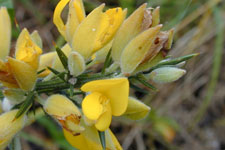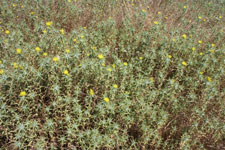Invasive Species
Invasive species are non-native plants that require special management due to their ability to spread easily and rapidly, often to the detriment of native and less vigorous plant species. Invasive species pose a risk to wildlife habitat by overcrowding and outcompeting established vegetation, growing densely such that wildlife cannot travel through or make use of the area, and threatening the ability of creeks, wetlands and uplands to maintain stable banks, flood areas, or terrain. Strategic removal of invasive species with the appropriate methods, (ie. Hand pulling, herbicide application, burning, etc.) can protect these ecosystems.
Species of Concern in the Gold Ridge Resource Conservation District
Gorse (Ulex europaeus)
 Gorse is a large, woody, perennial shrub with yellow pea-like flowers and spiny leaves. It is highly flammable and poses significant fire hazard. Gorse outcompetes native plants and desirable forage species by forming dense monocultures. This plant can produce up to 2 million seeds per acre. The seeds can remain viable in soil for up to 30 years.
Gorse is a large, woody, perennial shrub with yellow pea-like flowers and spiny leaves. It is highly flammable and poses significant fire hazard. Gorse outcompetes native plants and desirable forage species by forming dense monocultures. This plant can produce up to 2 million seeds per acre. The seeds can remain viable in soil for up to 30 years.
Purple Star Thistle (Centaurea calcitrapa)
 Purple Star Thistle is an annual to perennial thistle with a deep taproot, bushy with purple flowers, and spiny foliage. It is undesirable to livestock and may suppress the growth of other plant species by releasing toxic substances (allelopathic).
Purple Star Thistle is an annual to perennial thistle with a deep taproot, bushy with purple flowers, and spiny foliage. It is undesirable to livestock and may suppress the growth of other plant species by releasing toxic substances (allelopathic).
Woolly Distaff Thistle (Carthamas lanatus)
 Wooly Distaff Thistle is a winter annual with a deep taproot. It grows tall with yellow flowers and spiny foliage. Like Purple Star Thistle it can injure livestock. It forms dense monocultures, displacing desirable forage, and its seeds are commonly carried in hay bales, animal fur, vehicles and mowers, as well as by water. These seeds remain viable in the soil for years.
Wooly Distaff Thistle is a winter annual with a deep taproot. It grows tall with yellow flowers and spiny foliage. Like Purple Star Thistle it can injure livestock. It forms dense monocultures, displacing desirable forage, and its seeds are commonly carried in hay bales, animal fur, vehicles and mowers, as well as by water. These seeds remain viable in the soil for years.
Tips for Managing Weeds on Your Land
Weed management varies with the species, site, season and severity of the infestation. But there are common strategies that can be used to manage weeds on rangeland or wild land, no matter the place or plant.- Prevention: Seeds can hitch rides in infested hay bales, soil, animal fur, hooves, manure, waterways, vehicles, roads, clothing and shoes, to name just a few. Take steps to avoid accidentally importing weed seeds.
- Early detection and rapid response (EDRR): Catching weeds early offers the best chance for eradication with minimal cost.
- Control: Control becomes necessary once weeds have become established and widespread. Eradication becomes unlikely, control efforts become more costly, and a long-term management plan is required.
- Restoration: Restoration is expensive and typically requires outside help and expertise. (Source: MALT)
Native Plant Nurseries
North Coast Native Nursery, PO Box 660 Petaluma, CA, 94953, 707.769.1213
[email protected]Buckeye Nursery, 2425 Adobe Road, Petaluma, CA, 94954, 707.559.7081
[email protected]California Flora Nursery, 2990 Somers Street, Fulton, CA 95439, 707.528.8813
Related links:
Bay Area Early Detection Network (BAEDN)
Cal WeedMapper
CDFA Noxious WeedsCDFA Noxious Weeds Photographic Gallery
Invasive Plants of California's Wildlands
Marin County Department of Agriculture/Weights and Measures
National Invasive Species Council